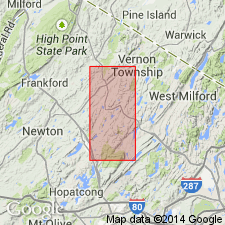
- Usage in publication:
-
- Pochuck gneiss*
- Modifications:
-
- Named
- Dominant lithology:
-
- Gneiss
- AAPG geologic province:
-
- Appalachian basin
Summary:
Pg. 439. Pochuck gneiss. The gneissic outlier of Pochuck Mountain is represented by two bands of rock. The eastern band, which adjoins the valley and forms eastern slope of Pochuck Mountain, we have called the Pochuck gneiss. Is about 1 mile in width and has been traced from near Hamburg to northern edge of area mapped. The prevalent rock type is a finely foliated gneiss, rich in biotite and hornblende and often grading into mica schist. With that type there are often associated bands of amphibolite gneiss.
Source: US geologic names lexicon (USGS Bull. 896, p. 1686).

- Usage in publication:
-
- Pochuck gneiss*
- Modifications:
-
- Overview
- AAPG geologic province:
-
- Appalachian basin
Summary:
Name Pochuck gneiss is here used to include all gneisses in Highlands region that contain hornblende, pyroxene, or mica as principal mineral constituents. Some of these rocks are probably of sedimentary origin, and others may be altered igneous rocks, but in general they are so completely metamorphosed that their original nature cannot be ascertained. Appear to be older than intrusive Losee and Byram gneisses. Include many varieties, but all characterized by dark lines attributable to presence of hornblende, pyroxene, or mica as important mineral constituents. Usually the only light-colored mineral present is oligoclase, but some facies contain considerable scapolite. Microcline observed occasionally, andesine and labradorite feldspar rarely. Rocks range from medium- to fairly coarse-grained; texture foliated granular. In Franklin Furnace area the gneiss passes beneath Franklin limestone. Although Pochuck gneiss and Franklin limestone are regarded as older than Losee and Byram gneisses, the original relations are not determinable.
Source: US geologic names lexicon (USGS Bull. 896, p. 1686).

- Usage in publication:
-
- Pochuck gneiss*
- Modifications:
-
- Revised
- AAPG geologic province:
-
- Appalachian basin
Summary:
Pg. 8. Pochuck gneiss. It seems probable the black gneisses which have been included under term Pochuck gneiss should properly be divided into two groups of different age and possibly of different origin, the first group comprising gneisses, possibly of sedimentary origin, older than Byram and Losee gneisses, and the second group comprising dark gneisses of igneous origin contemporaneous with Byram and Losee gneisses. The latter group would probably include the dark gneisses intrusive in Franklin limestone. The two groups have not been separately mapped because of impossibility of discriminating them in field.
Source: US geologic names lexicon (USGS Bull. 896, p. 1686).

- Usage in publication:
-
- Pochuck gabbro gneiss*
- Modifications:
-
- Overview
- AAPG geologic province:
-
- Appalachian basin
Summary:
The name Pochuck gabbro gneiss is now [ca. 1938] restricted by the USGS to the black gneiss of intrusive igneous origin, and the older dark gneisses of sedimentary origin that formerly were included under the name Pochuck gneiss are now [ca. 1938] included in Pickering gneiss.
Source: US geologic names lexicon (USGS Bull. 896, p. 1686).

- Usage in publication:
-
- Pochuck gneiss*
- Modifications:
-
- Revised
- AAPG geologic province:
-
- Appalachian basin
Summary:
Pochuck gneiss as previously defined includes two groups of dark gneisses of different age and different origin, one group comprising sedimentary gneisses that are older than the Byram and Losee types and of pre-Franklin age, and the other comprising igneous rocks that may be differentiates of Byram and Losee magmas. In this report name Pochuck gneiss is restricted to igneous rock; the older dark- and light-colored schists and gneisses and slaty rocks of sedimentary origin are mapped and described as Pickering gneiss. Formation to which name Pochuck gabbro gneiss is herein applied is a black or dark-gray rock with chemical composition of many diorites and gabbros, but differing from them mineralogically in containing orthoclase, microcline, and oligoclase rather than the more basic plagioclases. Considered to be older than the more granitoid Byram and Losee gneisses. Where the Pochuck is associated with Losee diorite gneiss, oligoclase is principal feldspar of the Pochuck; where it is closely associated with Byram gneiss, microperthite and microcline are prominent in the black gneiss and hornblende exceeds diopside.
Source: GNU records (USGS DDS-6; Reston GNULEX).

- Usage in publication:
-
- Pochuck Gneiss
- Modifications:
-
- Not used
- AAPG geologic province:
-
- Appalachian basin
Summary:
The Pochuck Gneiss as previously mapped in Franklin Furnace and Raritan quads (Spencer and others, 1908; Bayley and others, 1914) contains mappable units of diverse character, including metasedimentary, igneous, and mixed origin. The name Pochuck Gneiss is inadequate and the report uses descriptive petrographic names instead. [This report does not formally abandon the name.]
Source: GNU records (USGS DDS-6; Reston GNULEX).

- Usage in publication:
-
- Pochuck
- Modifications:
-
- Not used
- AAPG geologic province:
-
- Appalachian basin
Summary:
Though the name Pochuck Gneiss was used on the old State geologic map of NJ for amphibolite in the Hamburg and Wawayanda quads, it has since been abandoned because the rocks classified as Pochuck are neither lithologically nor stratigraphically distinctive. [No reference given for abandonment.]
Source: GNU records (USGS DDS-6; Reston GNULEX).
For more information, please contact Nancy Stamm, Geologic Names Committee Secretary.
Asterisk (*) indicates published by U.S. Geological Survey authors.
"No current usage" (†) implies that a name has been abandoned or has fallen into disuse. Former usage and, if known, replacement name given in parentheses ( ).
Slash (/) indicates name conflicts with nomenclatural guidelines (CSN, 1933; ACSN, 1961, 1970; NACSN, 1983, 2005, 2021). May be explained within brackets ([ ]).

